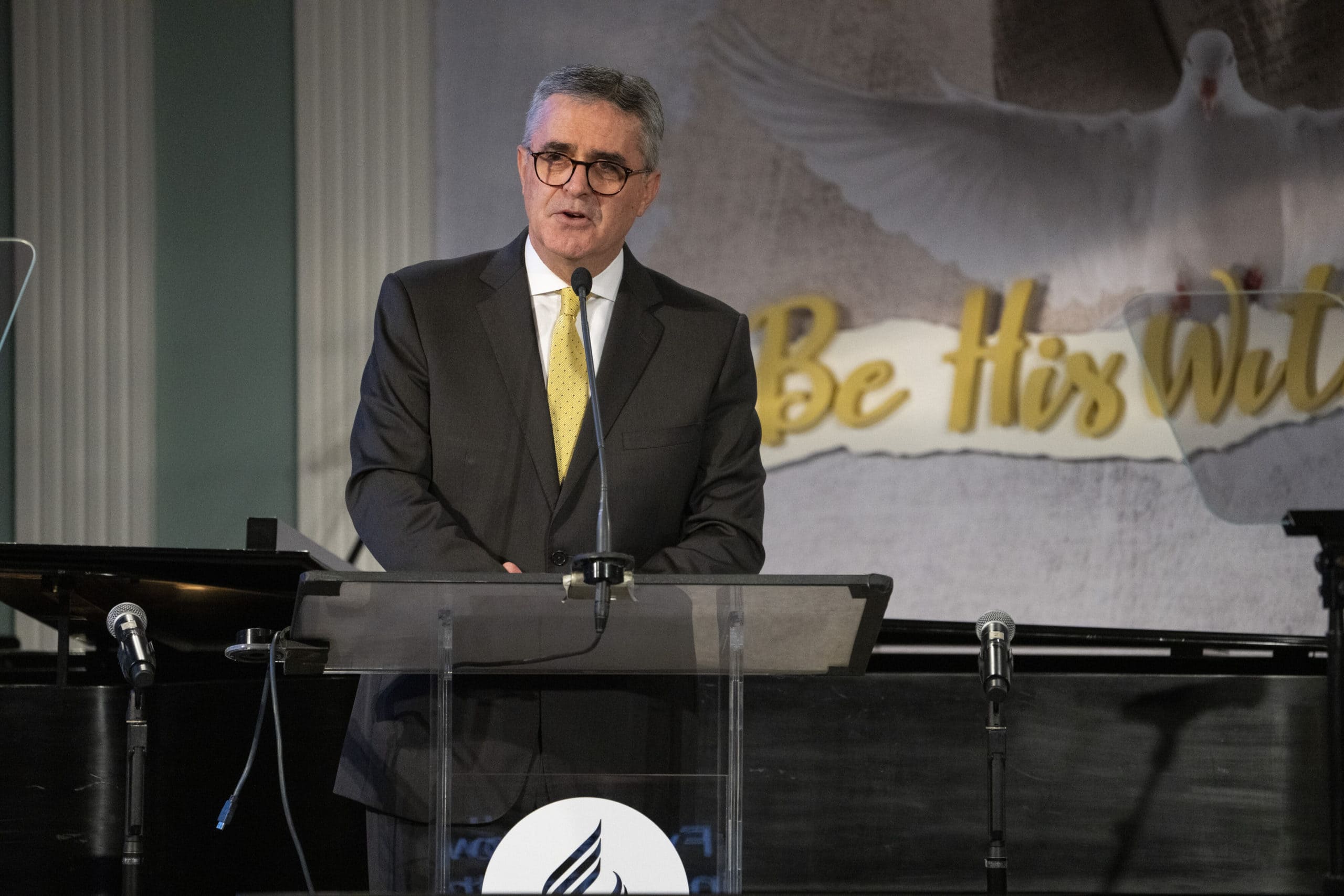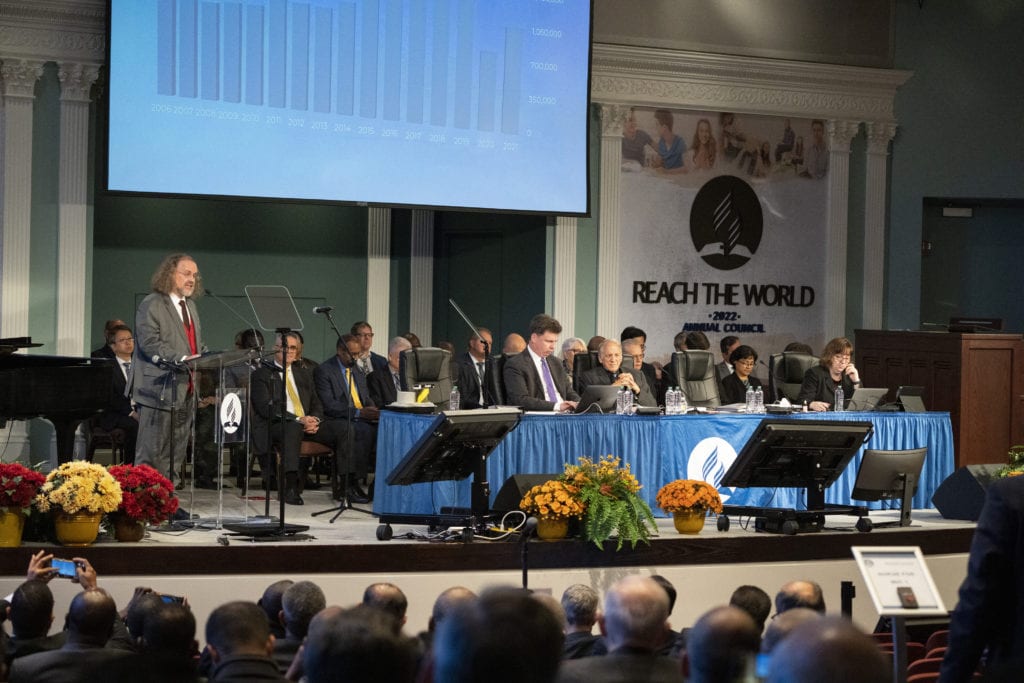
The General Conference (GC) Secretary’s Report at the 2022 Annual Council called on leaders to support a plan to refocus the Seventh-day Adventist Church’s priorities for missions worldwide. Members of the Secretariat team presented key parts of the report on October 9 at the church’s headquarters in Silver Spring, Maryland. Presentations covered the past—the historic mission tradition of the Adventist Church; the present—what current statistics indicate; and an emphasis on the future—how a suggested new model of using more resources for mission would work.
“The Seventh-day Adventist Church was not called to be a parking lot but a launching pad,” GC executive secretary Erton Köhler said. “We need to move forward in faith.”
Köhler reminded the more than 340 delegates attending Annual Council that the Adventist Church has been called to a global mission. In 1900, 83 percent of Adventist members lived in North America, he shared. In 2022, that figure has declined to 6 percent. “We are a global church with a global mission,” Köhler said. “We cannot focus only on our local needs; we need to look at our global challenges to finally preach the gospel of the kingdom to all the world.” And he added, “At Secretariat, we are working focused on that commitment.”

LONGSTANDING FOCUS ON THE MISSION FIELD
Office of Archives, Statistics, and Research (ASTR) director David Trim shared how in 1903 the Adventist Church “underwent a dramatic reorganization to ensure that the [church] could reach out to all the world.”
The focus of General Conference leaders at that time was on “unentered territories and unreached people.” It is what they called “the mission field,” which was vast, Trim said, because it included “all areas outside the homelands” of North America, Central and Western Europe, and Australasia. “These home fields were expected to take the message to the mission field,” he said.
Trim underlined the current need to send missionaries to frontline mission work more than to administrative positions. That need has moved Adventist leaders serving in the GC Secretariat to suggest a mission refocus model, he said.
REFOCUSING ON MISSION
The slow drift from focusing on frontline missionaries to other areas of service has motivated leaders to devise a plan to refocus on the mission of the church, GC associate secretary Karen J. Porter explained as she introduced her report. “The challenge now is . . . how to use our mission resources by identifying mission-critical people groups and locations that have not yet been reached with the gospel,” she said.
Porter explained that international service employees (ISEs)—missionaries sent by the church to serve in other regions of the world church—are serving in various capacities around the globe. Those serving in administrative positions, however, currently represent 35 percent of the total. Others serve the Adventist Development and Relief Agency (ADRA) or in education, medical institutions, or auditing services. “While these categories of assignments are good, we must put more emphasis on reaching the unreached,” Porter said.
NEW MISSION PRIORITIES
In April 2022, the GC Mission Board voted on new priorities for sending missionaries, in what Porter defined as its “new mandate.” Priorities include direct-contact mission to create new worshipping groups, urban areas of more than 1 million population, and 10/40 window countries and people groups of non-Christian religions. (The 10/40 window is a region of the world where a majority of the world’s population lives but where Christians are in the minority.)
Porter also prioritized postmodern and post-Christian regions, low Adventist-to-population ratio sectors, and high-impact equipping for direct-contact mission.
The goal is to have 35 percent of the mission and international employees’ budgets meet the criteria by 2027 and 70 percent by 2032, she reported. “We realize this is a very ambitious goal,” Porter said, “but we also realize that with all of us working together in unity, we can effect this change.” She explained, “We are not saying that the positions that do not meet the criteria are not important or are not needed: we are only saying that these criteria are our priority today.”

A NEW ASSESSMENT SCALE
It’s all about acknowledging that the Adventist Church can improve the way it uses resources for mission, Porter said. But at the same time, the shift will be accomplished carefully and methodically, not randomly. For instance, GC Secretariat has created a scale to evaluate primary budgets by asking seven key strategic questions that reflect the priorities voted by the Mission Board. Porter explained that each question had been assigned a range of points, and each budget was analyzed based on how closely the position focused on the priorities. “Three hundred and twenty-seven individual budgets have been put through this matrix,” Porter reported.
The questions include: How focused is the position on direct--contact mission with the goal of creating new worshipping groups? And, How focused is the position on training local people for direct--contact mission?
Porter reported that among the budgets the Secretariat team analyzed, only one reached the ideal 31 points. The funding in question has been assigned to a church planter who serves in a 10/40 window country, in a city of more than 1 million, and in direct-contact ministry. Those resources are also used at a local level (non-administrative), and the ratio of Adventists to the population is high (i.e., few members, as compared to the overall population).
HOW TO MOVE FORWARD
Porter reported that next, the Mission Board is planning to review the budgets of international missionaries with divisions and institutions and that divisions and institutions will work on a plan to reassign budgets to mission priority areas. The Mission Board will also determine the mission-matrix threshold (i.e., the minimum number of points required in each specific case). “It will be somewhere between 15 and 20 [out of 31] points,” Porter said.
She also shared that some projects already meet the new criteria, such as Mission Unusual Tokyo, Hope for Kolkata, and a special project in an unidentified country that restricts mission activity. She encouraged leaders to use Adventist Mission data to identify strategic mission opportunities. Those data can inform Global Mission leaders and other decision-makers to align their projects with these new criteria, she said. “As we refocus our mission resources, I challenge you to think about what sacrifices you are willing to make so that those who haven’t heard about Jesus . . . can also hear this message,” Porter said.
Köhler summed up the component pieces reported by the Secretariat team. “Our main challenge is to keep focused on what our real priority is,” he said. “It’s time to work together . . . to refocus on our mission.”